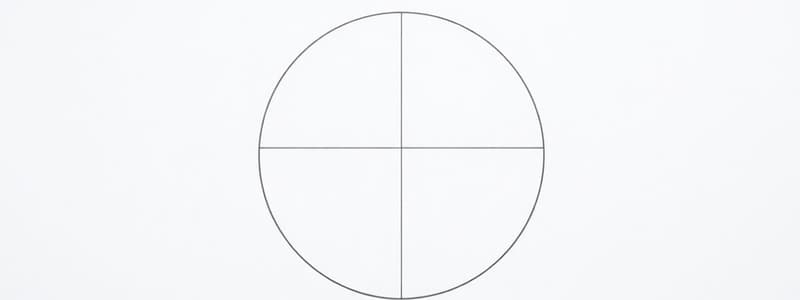Podcast
Questions and Answers
Which of the following statements about operations on rational numbers and powers of natural numbers is NOT correct?
Which of the following statements about operations on rational numbers and powers of natural numbers is NOT correct?
- Rational numbers can be added, subtracted, multiplied, and divided.
- Dividing two rational numbers always results in another rational number. (correct)
- Raising a natural number to a power involves repeated multiplication.
- Powers of natural numbers can only result in positive integers.
It is possible for the volume of a geometric figure to be numerically equal to its surface area.
It is possible for the volume of a geometric figure to be numerically equal to its surface area.
True (A)
Two angles are said to be ___________ if the sum of their measures is 180 degrees.
Two angles are said to be ___________ if the sum of their measures is 180 degrees.
supplementary
If the area of a rectangle is 48 square units and one side has a length of 6 units, what is the length of the adjacent side?
If the area of a rectangle is 48 square units and one side has a length of 6 units, what is the length of the adjacent side?
Match each type of angle with its corresponding degree measure range:
Match each type of angle with its corresponding degree measure range:
Flashcards
What are Equations?
What are Equations?
Mathematical statements showing equality between two expressions.
Systems of Linear Equations
Systems of Linear Equations
A set of two or more linear equations that are solved together.
What are Lines?
What are Lines?
Straight paths that extend infinitely in both directions on a surface.
What is Volume?
What is Volume?
Signup and view all the flashcards
Supplementary Angles
Supplementary Angles
Signup and view all the flashcards
Study Notes
- Rational numbers can undergo operations like addition, subtraction, multiplication, and division.
- Natural numbers can be raised to powers, which involves repeated multiplication of the base number.
Angles
- Acute angles are less than 90 degrees.
- Right angles are exactly 90 degrees.
- Obtuse angles are greater than 90 degrees but less than 180 degrees.
Equations, inequalities and systems of linear equations
- Equations: Mathematical statements showing equality between two expressions.
- Inequalities: Mathematical statements comparing two expressions using symbols like <, >, ≤, or ≥
- Systems of linear equations: A set of two or more linear equations that are solved together.
Area
- Area of a rectangle: Calculated by multiplying its length by its width.
- Area of a triangle: Typically calculated as one-half of the base multiplied by the height.
- Area of a circle: Calculated using the formula πr², where r is the radius.
Lines and Rays
- Lines: Straight paths that extend infinitely in both directions on a surface.
- Rays: Start at a point and extend infinitely in one direction.
Volume and Surface Area
- Volume: The measure of the amount of space inside a three-dimensional figure.
- Surface area: The total area of all the surfaces of a three-dimensional object.
Angles
- Supplementary angles: Two angles whose measures add up to 180 degrees.
- Sum of angles in a triangle: The sum of the interior angles, which is always 180 degrees.
- Sum of angles in a quadrilateral: The sum of the interior angles, which is always 360 degrees.
Mathematical Logic
- Mathematical logic deals with reasoning and proving mathematical statements.
Studying That Suits You
Use AI to generate personalized quizzes and flashcards to suit your learning preferences.
Description
Rational numbers, powers of natural numbers, different types of angles, and equations, inequalities. Area of a rectangle, triangle and circle. Plus lines and rays.




